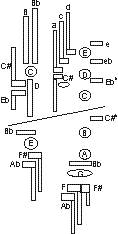¡¡Updating Aug-Oct, 2010!!
Fingerings, Tablature and Spectrum Analysis
pdf of Multiphonics by Present internal pitches (@A=440 Hz)
Multiphonic Charts
Chart pages will be added as they are completed --new notes will come last.
Having a set number of multiphonics easily (and a little too reflexively) at my fingertips (many originally learned from the Methodo Per Fagotto by Bruno Bartolozzi and Sergio Penazzi, the others learned from years of playing extended technique in improvisations) I was wanting to further analyze and catalogue them both for my own better understanding and because my results often did not concur with those that were also analyzed by Bartolozzi in his method. In the process I discovered many new ones I had not known before. Most of these have probably already been cataloged in some form before but I hope that these notes will be a helpful supplement.
With several recordings of each multiphonic and using a couple of different reeds, an attempt was made to note some of the most prominent repeatable frequencies present in these tones. They are much more complex and variable than what is transcribed here and it is precisely their richness and complexity that is what is most appealing about them. Subtle changes in embouchure and air flow can highlight or change different frequencies and create dynamic and amorphous textures which have a multi-dimensional spacial feel.
Fingering Diagram

The layout of keywork and tone-holes of the bassoon is done schematically - tone-holes and keys are labeled on this chart. Shaded tone-holes or keys simply designate what tone-hole is covered or key depressed. Partly-shaded keys designate some additional keys or tone-holes that may be used on a particular multiphonic-- these do not appear in the staff notation. The possibilities of alternate and resonance keys are much more extensive that those noted here and results in tone and pitch can be significant as examples show below.
Dotted fingering charts designate multiphonics that are a little more difficult to obtain consistently and/or can be a little unstable.
Multiphonic Tablature Notation
An attempt has
been made for a possible tablature notation of each multiphonic. The
large note on the staff designates the base fingering (to be read in
bass clef) which is used
as foundation
fingering for the multiphonic. The small shaded note corresponds to the
tone-hole
or key that is to be added to the base fingering. The small empty note
corresponds to the tone-hole or key that is to be removed from the base
fingering.
Register and wing keys are noted by
there key name
above the
staff (c#, a, c &d) as are trill keys (C#tr,
Ebtr).
Many of these
multiphonics are more closely related to tenor register notes, but
first register fingerings are maintained as reference in order to avoid
any confusion caused by the plethora of alternate fingerings that exist
in upper registers.
Possible additional resonant keys are
not shown in
staff notation as they were not used in the sampled recording. Here are
some examples of how significant these keys can be in changing a chord
make-up.
 ,
,
 .
.
Chord Notes
Frequencies were forced into a 1/4 tone equal tuning system when in reality they can lie anywhere/everywhere on the spectrum as given by this example -- so pitches must be considered approximate.
Consonant Chords:
Most of
the lower and mid register
multiphonics have
strong resulting tones or bell-tones whose frequencies do not register
with spectrum
analysis. The most present ones are designated by blue notes and their
true octave can
shift or be a little ambiguous.
The lowest registered frequency is noted with a red note - this frequency is often inaudible (there can be lower frequencies than these, but of too slight a db level and too broad a range to specify). The rest of the black notes are select frequencies that can actually be heard in varying degrees.
Beating Chords:
By their very nature these multiphonics
are made up
of competing or intermittent frequencies that are often concentrated in
multiple clusters as seen in this
example. Where possible frequencies
are charted as they are for consonant chords but in addition: grey
notes designates the low end of a 1/4 tone fluctuating/multiple
frequency; blank
notes designate the mid point of 1/4 tone fluctuating/multiple
frequency;
heavy-outlined notes designate clear intermittent frequencies. Sound
samples are a little longer to give an example of how air flow can
change/control the beating.
In this
example:
Fingering
notation:
(to be read in bass clef)
Low F is fingered; low C# added while left index E tone-hole and right
G key removed.
Frequencies
present:
The red D in the bass clef is the lowest registered frequency.
The blue F-1/4 tone sharp, is an audible 'bell' or resulting
tone
not present in analysis.
Other frequencies include in varying degree of audibility;
A-1/4 tone
sharp in bass staff;
D, E & F# above middle C; C, D-1/4 tone sharp
in the following octave.
Graphs and Sound
The multiphonic graphs are split into two categories -- those whose chords are closer to consonant and those that are extremely discordant with very strong internal beatings. There are of coarse several that could fall on either side of this divide. The consonant set are loosely ordered micro-chromatically with lower multiphonics first.
Although sound compression does not do these samples complete justice, each graph is linked to a 6 second MP3 sound sample that can be heard by clicking on the image. For the sake of this project, multiphonics were played as consistently and steadily as possible but as mentioned earlier subtle changes in embouchure and air pressure can easily alter results as heard in these examples:

